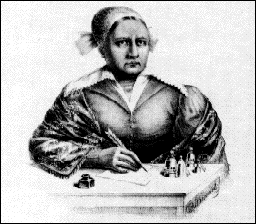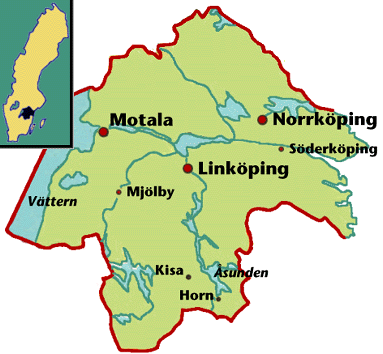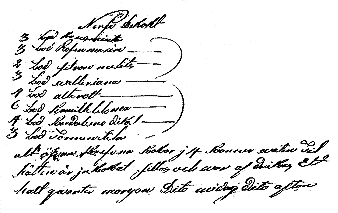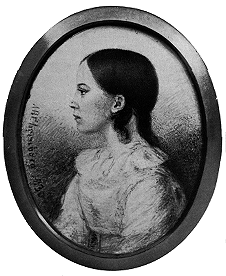
A sturdy woman with blue penetrating eyes ...
Kisamor - female
natural healer
in Sweden (1788-1842)
English summary
Her father was also a famous natural healer, but he did not want his daughter to devote her life to this craft; she could never be more than a bad quack, he claimed, since she was a woman. But secretly she learned all of her father's skills, by lurking in the background while he treated his patients.
Kisamor received patients on a regular basis at the Kisa inn. People came from all the Nordic countries to the little village of Kisa in the Östergötland county, but mostly they came from Stockholm and the county of Värmland.
Pretty much has been written about Kisamor in Sweden, most of it is based upon oral tradition or earlier secondary sources. I would not maintain that most of that is erroneous, but primary sources are scarce. Rumors have it that Kisamor once cured King Karl XIV Johan and the Crown Prince Oscar. After an investigation by the National Board of Health (the Sundhetskollegiet) she was supposed to have become a sort of registered physician. This, however, has not been possible to verify. [See Note 2!]
Kisamor's real name was Maria Jansson (sometimes spelt Jaensson) and she was born on July 30th 1788 at the Kvarntorp cottage in the parish of Hardemo, Örebro county, Sweden, as the fourth child of the farmer Johan Johansson and his wife Kerstin Nilsdotter. Kisamor practised natural medicine, beginning at the age of 13.
Between 1807 and 1819 she was married to the farmer Anders Olsson. This marriage was forced upon her by her father, as a means to keep her from performing medical duties. Instead she was to devote herself to her husband and to housekeeping.
This marriage was of course unhappy. In the spring of 1810, soon after her first child had been born and soon thereafter died, Kisamor escaped from home, eventually returning after much pursuasion. She hoped do endure the marriage until her father died. Another daughter was born in 1811. This child died too, only a few months old. This was probably part of her reason for definitely leaving the marriage. At this time Kisamor was also arrested for having poisoned a farmer, who died because he took the wrong dosage of the prescribed medicine. The court decided that Kisamor "herafter was not to concern herself with the curing of illnesses".
But Kisamor did not cease to cure. In 1813 she was invited to the Åby manor i the nearby parish of Horn to treat a former mining superintendent, Nils Wibjörnsson, afflicted with cancer. Kisamor was considered a specialist on this disease as well as on pulmonary consumption. She seized this opportunity and travelled down to Åby and managed to cure her patient. Then she met the two Hellwegh sisters, relatives of the recovered Wibjörnsson, and they invited Kisamor to settle down at their farm Flytthem. Kisamor accepted. Her practice in Horn was successful. During the first years she travelled the countryside, making housecalls, and therefore she was at first called Åkar-Maja (appr. "Travelling Mary"). She also had scheduled visiting hours at the Kisa inn, and eventually she got the name Kisamor.

The county of Östergötland, Sweden
In 1815 she did something really remarkable for her time. She had long tried to get a divorce. Now she sued her husband for "bad householding and misconduct". A very difficult period followed, where trials were postponed and resumed. In 1818 Kisamor's husband threatened to shoot her or beat her to death. At last, after six trials she got her divorce in 1819.
Between the years 1820 to 1824 Kisamor had a devoted admirer in Amalia Rääf, who wrote large numbers of letters, one each day, filled with emotion and romantic infatuation. Amalia, who at this time was in her early thirties, often wrote about the "peace of the grave" and her hopes to meet Kisamor one day on "the other side". She called herself Kisamor's daughter and spoke frequently in her letters about the bliss to cry and be comforted in Kisamor's arms. They met now and then in Tuna, where Kisamor treated Amalia's sister Charlotte.
The number of patients that came to see her increased steadily. To get better ackommodation facilities she also used the Stora Flarka inn, starting in 1829. Even today there is a room called "Kisamor's chamber" at Stora Flarka. She also lodged several patients at Katrineberg, a house belonging to the Åby manor. Kisamor rented this place in 1827, and she lived there for the rest of her life.
One of Kisamor's prescriptions in her own hand, a concoction for "the nerves". More documents in full sized facsimiles, see the Kisamor documents overview.
Among her preserved recipes are remedies for gout, cholera, malaria, consumption, ringed worm, scabies etc. Her medicine for malaria contains chinchona bark, myrrh, sugar, and elderberry juice. A decoction for consumption includes garlic, calamus root, buckbean and polypody; 65 grammes of each to appr. 13 (American) quarts of water. This should boil until the liquid has reduced to appr. 5.5 quarts.

Betty Ehrenborg
The best and most trustworthy portrayal of Kisamor is the diary of Betty Ehrenborg, a young authoress, who was treated by Kisamor in 1839. The 21 year old Betty recorded her impressions of Kisamor in her diary (available at the Origo section in Swedish) every day, but in French, to keep the notations safe from Kisamor, who, of course, didn't speak this language.
Kisamor was a sturdy, mannish, temperamental woman, of average height, with blue penetrating eyes. As a young woman she was gentle and good-humoured, but success seemed to make her more arrogant and despotic. During the last decade of her life she was addicted to alcohol and became rather red-faced. All of her patients, rich people as well as poor, were treated alike - according to her present mood, however. When she died, on February 27th 1842, she left behind 20,292 riksdaler ("rix-dollars", i. e. national dollars), today comparable to at least $150.000.
Literature about Kisamor (archival manuscripts not included):
T Björck: "Lefnadsteckning af fru Janson, vanligen kallad Kisa-Mor" (1842).
W. Grawallius: "Från Östergötlands bygder" (1890), p 170-84.
"Lefnadsteckning öfver Kisa-Mor" (published by the Chemical factory in Östersund 1893).
"Pharmaca composita" (l89l), p 83.
Carl Bernhard Wadström: "Ur minnet och dagboken. Anteckningar från åren 1848-1897." Del 1 (Stockholm 1897).
G Taube: "Betty Ehrenborgs besök hos Kisamor" (Östergötlands fornminnes- o museifören l945-1947; also in the book "Från gångna tiders Uppsala", l950).
"Kindasocknarna Horn och Hycklinge i ord och bild" (Vimmerby 1983).
Pia Höjeberg: Kisamor (1990).
Note: The article, which is summarized here, is an edited version of a lecture held by Karl-Henrik Tallmo in Hardemo 1972. Karl-Henrik Tallmo made extensive research about Kisamor 1968-72. A planned book was never completed, since he died in 1977. Much of Tallmo's research is, however, included in Pia Höjeberg's book from 1990.
Note 2: Höjeberg (1990) quotes Wadström (1897) and Kindasocknarna Horn och Hycklinge (1983), and claims that Kisamor did visit Stockholm on two occasions, both involving sick-calls at the Royal palace, in 1824, 1825 or 1826, as well as in 1840 or 1841. There was a Jonas Jonsson who helped Kisamor with paperwork, who had seen a document, signed by the Sundhetskollegium, stating that Kisamor "was allowed to freely practice the medical profession all over Sweden". And Wadström had met Kisamor at a Jenny Lind recital in a privat home. He says that Kisamor visited Stockholm to give advice to one of the the royal ladies who had taken ill.
This summary, © copyright Karl-Erik Tallmo, 1995.

